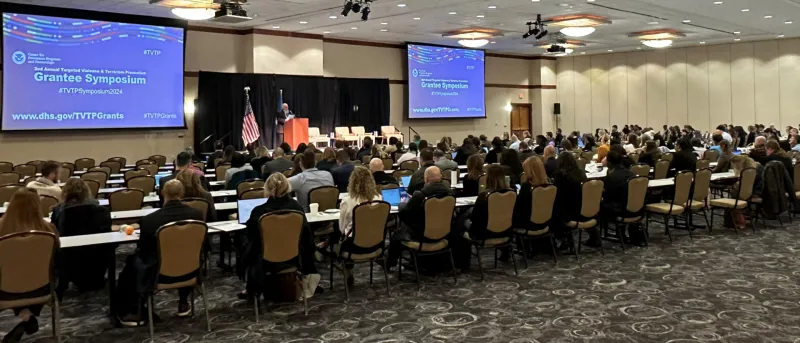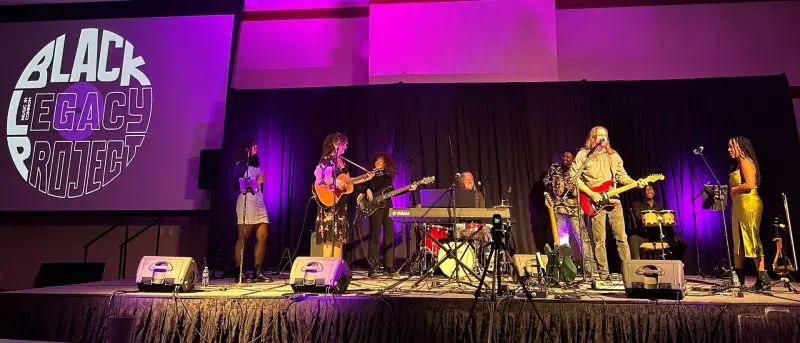
The DHS Center for Prevention Programs and Partnerships (CP3) hosted its second annual Targeted Violence and Terrorism Prevention (TVTP) Grantee Symposium on February 1-2, 2024. The symposium brought together more than 300 people, representing 113 grantee and partner organizations, nine DHS offices and federal entities, such as the Department of State, Department of Justice, National Counterterrorism Center, and National Security Council, as well as the House and Senate Committees on Homeland Security.
The goals of the Symposium included fostering grantee collaboration with other grantees, CP3, and interagency partners; sharing promising practices, lessons learned, and strategies for overcoming challenges. Discussion themes included the importance of leveraging existing programs that bolster protective factors in communities; building and maintaining trust through intentional partnerships; determining roles, responsibilities, and capabilities of organizations upfront; and focusing on end goals when initiating a project to ensure sustainability.
“We have turned a corner. In the last several years, we have gone from primarily admiring the problem to implementing and evaluating evidence-based practices to decrease the likelihood of violence.”– CP3 Director William Braniff
The symposium provided a venue for grantees to cultivate new partnerships, share the impact of their work, and build connections for future collaboration. Recommendations for future symposium topics include program evaluation and impact measurement, TVTP in underrepresented and underserved communities, and outreach strategies for gaining new community partnerships., and panels or sessions focusing on primary, secondary, and tertiary prevention to allow practitioners working in the same chronological stages or prevention levels to learn from one another.
Grantees also met in regionally based breakouts to discuss topics specific to where they work: East, Central, Mountain, and West.
CP3 hosted its first TVTP Grantee Symposium in 2022. Read more about the 2022 event.
CP3 Associate Director for Grants and Innovation David O’Leary welcomed the attendees, provided an overview of the Grant Program, and set expectations for the two-day symposium agenda. He noted that the intended goals for the symposium were to share promising practices and lessons learned among grantees, establish connections to increase collaboration, showcase grantee projects, and connect grantees in-person with their grants managers and other federal partners. “We are proud of the important work that we do at CP3, and we are proud of the partnerships we have with all of you because of what you do to keep your communities safe,” he explained. “We come from such a variety of professional and educational backgrounds that we are able to approach the problem of targeted violence and terrorism from so many different perspectives and to bring to bear the unique sets of resources prevention requires.”
Moderator
Kira Hamman (Urban Rural Action)
Panelists
- Kevin Brown (Network of Academic and Scholastic Esports Federations);
- Dr. Heidi Ellis (Boston Children’s Hospital);
- Dr. Suranjan Weeraratne (Southern Illinois University at Edwardsville); and
- Dr. Laurie Rice (Southern Illinois University at Edwardsville).
About the Panel
This panel discussed the importance of community engagement in TVTP work. Panelists considered leveraging and building on existing strengths to better combat threats. Panelists noted that focusing on any threat to community cohesion is key—many who empathize with violence feel isolated from those around them, so it is important to think of this work as a “path to safety and wellness” rather than focusing on “threat assessment.” The use of language is key in these discussions so that communities feel empowered.
The panel ended by discussing the roles each level of society must play in violence prevention, emphasizing that it is important to build upon each other’s strengths rather than focusing on finding gaps.
Moderator
Bruno Dias (CP3)
Panelists
- Patricia Kickland (Hawai’i Department of Defense);
- Carl Amritt (District of Columbia Homeland Security and Emergency Management); and
- Captain Randy Foley (Palm Beach Sheriff’s Office).
About the Panel
This panel discussed Behavioral Threat Assessment and Management (BTAM) and its practical application in communities. Panelists discussed the importance of not reinventing the wheel of threat assessment by leveraging expertise in communities to collect and implement best practices in BTAM. This also includes using existing partnerships to create centralized networks of BTAM practitioners and understanding the role that different community members play in violence prevention. Panelists also noted that approaching BTAM as a resource encourages people to proactively reach out and engage, thus moving violence prevention work out of a more reactive space. The goal is to get more of the right people involved so that there are no missed threat reports or management opportunities and options. One panelist noted that there are multiple pathways to safety.
The panel concluded with emphasizing that the goal of threat assessment is to develop nonpunitive support systems focused on the individual and their behavior. Everyone in the violence prevention space wants to help people, and leveraging different vantage points and approaches to this assistance will only make practitioner networks stronger.
DHS Counterterrorism Coordinator Nicholas Rasmussen provided a keynote address outlining the current terrorist threat in the United States. “We are dealing with lone offenders or small groups motivated by an increasingly wide range of ideologies and personal grievances,” he explained, and recognized prevention as an essential element of homeland security. “To respond effectively to this threat, the Department has embraced a community-based approach to preventing terrorism and targeted violence that prioritizes building trust and habits of collaboration across every level of government, the private sector, non-governmental organizations, and the communities we serve while respecting First Amendment protections.”

Music In Common's Black Legacy Project (LP) is a national initiative that aims to bridge cultural gaps and strengthen communities through music. The project brings together artists from diverse backgrounds to record present-day interpretations of Black American songs and original compositions. The project includes community roundtable discussions, concerts, and film screenings of the Black LP docuseries. At this year’s symposium on the first day of Black History Month, MIC showed the first part of their docuseries, and the 8-piece Black Legacy Project band performed a 15-song set showcasing 13 of the 24 songs recorded for the project. Over 100 symposium participants attended this optional evening event. Two additional songs - Sam Cooke’s “A Change Is Gonna Come” and Woody Guthrie’s “This Land Is Your Land” opened and closed the set respectively, with Woody Guthrie’s great grandson, Krishna Guthrie, leading the band in the latter.
Assistant Secretary for Counterterrorism, Threat Prevention, and Law Enforcement Policy Jeohn Favors concluded, “DHS is committed to driving targeted violence and terrorism prevention programs forward based on the evidence base for violence prevention. DHS is committed to contributing to that evidence base as it relates to targeted violence and terrorism prevention specifically, and to ensuring that CP3’s technical assistance is based on publicly available research to help promote widespread adoption of promising practices, and DHS is committed to administering this public health-informed violence prevention mission transparently.”
Moderator
Tom Crick (Carter Center)
Panelists
- Bev Baligad (University of Hawai'i-West O'ahu);
- Michele Hillen-Noufer (Nu Art Education, dba NorCal School of the Arts); and
- Ray Kim (International Center for Religion and Diplomacy).
About the Panel
This panel discussed how best to build sustainability into TVTP programs. The panelists discussed the importance of not waiting until the grant money runs out to determine the next steps. It is important to plan in advance for how to continue a project or initiative once the grant ends and write grant applications with those goals in mind. Relying on the motivation and commitment of partners is also key to ensuring the work continues even if the funding is in flux. Committing to deeper work within communities, showing up, and inciting culture change will lay strong groundwork for sustaining programs, and mapping out scaled solutions will also help practitioners to identify resource needs moving forward. Panelists discussed these sustainability best practices in the context of their projects: school-based threat assessment and management teams, conflict resolution through theater arts, and resilience-building against religious polarization.
The panel ended with discussions of how to ensure TVTP projects last and make a significant impact. Panelists talked about how important it is to get the community involved, change the culture for the better, and work together from the start. This includes building relationships before you need them, as well as mapping out roles and responsibilities to effectively work together.
Moderator
Diana Hughes (Parents 4 Peace)
Panelists
- Dr. Emma Cardeli (Boston Children’s Hospital);
- Dr. Juncal Fernandez-Garayzabal (Counter Extremism Project);
- Courtney Tassin (City of Aurora); and
- Kevin Lambert (Parents 4 Peace).
About the Panel
This panel discussed best practices for relationship-building and determining community and partner readiness to engage in the TVTP space. Overall, the four panelists discussed the importance of supporting what their communities already have in place and to lean into the strengths of existing ecosystems. This approach minimizes duplication of effort and ensures that prevention providers build upon what is already working by understanding what gaps grantee projects can fill – starting with the simple question, “what can we do to help?” This process also involves proactive engagement and partnership-building to ensure the community knows these relationships exist and can be activated at any time, not just during a crisis.
The panel ended by discussing the importance of incorporating preventive factors into everyday life through the influence of the media, storytelling, moving beyond awareness campaigns, and intentionally building community partnerships at the start of a project.
CP3 Director William Braniff discussed the role of CP3 in nationwide TVTP efforts. He reflected on developments in the field of violence prevention. “We have turned a corner. In the last several years, we have gone from primarily admiring the problem to implementing and evaluating evidence-based practices to decrease the likelihood of violence,” he explained. Braniff called for more resources to scale up promising practices. “It is time for the United States to start making pivotal strategic investments that can move the needle nationally, while continuing to replicate and evaluate the promising practices that our grantees have pioneered.”
